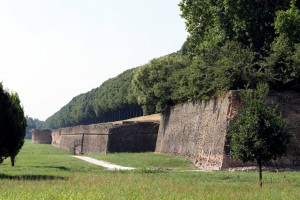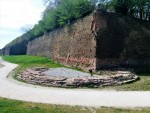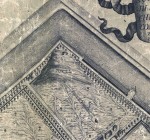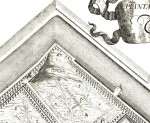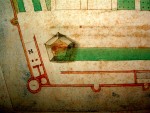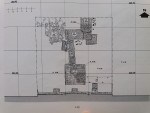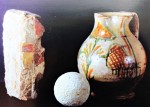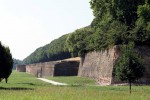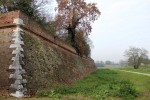Punta della Montagnola
Torrione di Francolino, later called Punta della Montagnola: an architecturally strategic site, altered over the centuries though still visually fascinating today.
The revelations of restorations and archaeological digs
Located at the north-eastern vertex of the fortified wall built between the end of the fifteenth and the beginning of the sixteenth centuries, the Torrione della Montagnola or Torrione di Francolino (the name of the town on the banks of the Po that it faces, a few kilometres away) endured significant structural modifications in the 1730s, specifically to the stretch of wall between the Torrione di San Giovanni and the Porta degli Angeli. Appraisals, documents, maps and drawings from 1724-1738 paint a picture of walls that were in a truly precarious and gravely compromised state, mainly due to the caving in of the foundations and collapses caused by the corrosive, degenerative damage caused by the moat water lapping against the surface of the wall. So, the authorities at the time decided to restore a total of over 400 meters of sunken curtain walls; replace the damaged foundations with new piles; knock down, rebuild and lower entire ruined wall sections; and topple circular defensive towers. This amounted to an impressive and expensive project, carried out ‘according to the most advanced rules of the craft’, as stated by Luigi Vanvitelli, the architect hired between 1735 and 1737 to verify their quality.
Sixteenth-century cartography documented the original layout of the walls at this point: the north walls, which split off from the Torrione di Francolino, were on a bit more of an advanced line than the current one, being shaped into two circular bastions before being sharply interrupted, bending at right angles to the south, against a more internal curtain wall, which formed a recess in the defensive perimeter.
In the early seventeenth century, the defensive tower was razed to the ground, and the documents from the second half of the century show no trace of even the first section of the north walls. However, the curtain wall was brought back to the inner line and surrounded by the eastern walls with the Punta di Francolino, re-built after the collapse in 1735, moving the section adjoining the east wall backwards.
The detailed archaeological study carried out in summer of 1990 brought important architectural evidence to light, especially in the area before the present-day Punta (paper F16) and at the end of the walls towards Porta degli Angeli (paper F11). Paper F16 identifies the foundations of the Bastione di Francolino, which already was visibly damaged, as documented by the deep lesions found along its entire thickness, which had already been documented in detail by Giovanni Giacomelli in a survey from 1735, now kept at the State Archive of Ferrara. Wood reinforcement poles plunged into the ground were discovered along the entire external perimeter of the structure. They were used to curb its drastic static instability, which later caused the collapse of the walls. In paper F11, during the dig, various connected structures were rediscovered, including a reinforced foundation made of plinths pertaining to the present curtain wall, reusing part of a twisted ring beam from the Rossettian walls (Visser Travagli; D’Agostini).
The archaeological dig also confirmed the documentary evidence on the collapses that took place during the early eighteenth century, having found piles of brick debris and numerous fragments of painted plaster. Some bricks still have a layer of red, green, black and white paint on the outer side. The debris deposit also covered some ceramic items, including a rounded mug, painted in irony yellow and coppery green with a poplar leaf motif, datable to the late sixteenth to seventeenth century. Today it’s stored (along with the other items found) at the Museums of Ancient Art of Ferrara.
The shelf that supported the watchtower built on the Punta is also still visible today.
Bibliography
- Anna Maria Visser Travagli, Notizia sull'indagine archeologica alle mura rossettiane di Ferrara, 1990, in Guido Biscontin, Daniela Mietto (a cura di), Le Superfici dell'architettura: il cotto. Caratterizzazione e trattamenti, Atti del convegno (Bressanone, 30 giugno-3 luglio 1992), Libreria Progetto Editore, Padova 1992, pp. 725-735
- Alessandra D'Agostini, Mura nord-orientali, in Anna Maria Visser Travagli (a cura di), Ferrara nel Medioevo. Topografia storica e archeologia urbana, Grafis, Bologna 1995
- Maurizio Bernardi, Michele Pastore, Il restauro delle Mura: gli interventi, in Maria Rosaria Di Fabio (a cura di), Le mura di Ferrara. Storia di un restauro, Minerva, Bologna 2003
- Francesco Scafuri, Le mura di Ferrara. Un itinerario attorno alla città, tra storia ed architettura militare, in Maria Rosaria Di Fabio (a cura di), Le mura di Ferrara. Storia di un restauro, Minerva, Bologna 2003
- Anna Maria Visser Travagli, Il contributo dell'archeologia al restauro delle Mura di Ferrara, in Maria Rosaria Di Fabio (a cura di), Le Mura di Ferrara. Storia di un restauro, Minerva, Bologna 2003
- Maria Teresa Gulinelli, Ricerche archeologiche nel tratto settentrionale delle Mura Estensi, in Maria Rosaria Di Fabio (a cura di), Le Mura di Ferrara. Storia di un restauro, Minerva, Bologna 2003
- Sabina Carbonara Pompei, Le mura di Ferrara nel XVIII secolo: interventi sulle lacune “secondo le buone regole dell'arte”, in Riccardo Dalla Negra, Alessandro Ippoliti (a cura di), Le lacune urbane tra passato e presente , Ginevra Bentivoglio Editoria, Roma 2017, pp. 125-138
Fototeca
Related Themes
Compiling entity
- Assessorato alla Cultura e al Turismo, Comune di Ferrara

